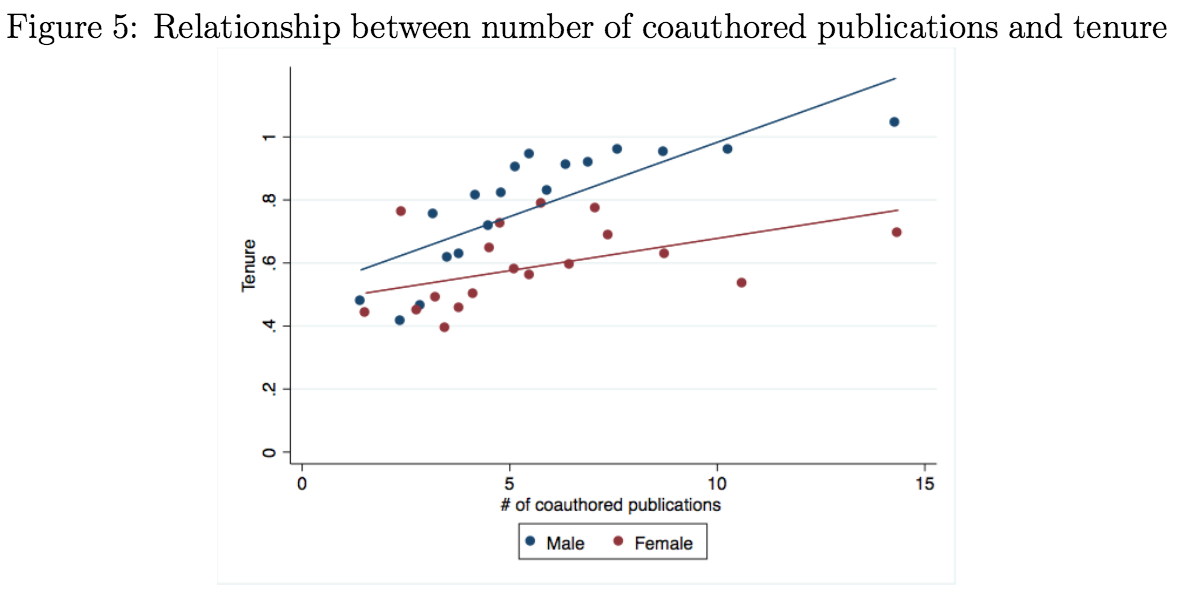A PhD student of economics at Harvard—Heather Sarsons—generated quite a buzz with her working paper, “Gender Differences in Recognition for Group Work” (HERE for the paper, and HERE for Justin Wolfers’ summary of her research in TheUpshot). Sarsons looked at the careers of young economists recruited by top universities in the U.S. over the past four decades. She discovered that while women publish at roughly the same rates as men, they are significantly less likely to achieve tenure, even after accounting for all the things one might first think to blame for this discrepancy (tenure rates at different universities, subfield differences, quality of publications, influence, etc.). There was one group of women, however, who received equivalent rates of success to men—women who publish without men, either alone or with other women. Simply put, Sarsons finds that when women publish with men, they do not receive the same credit.
 Both of us are sociologists. And, in Sarsons’ paper, she also analyzed sociology and did not find the same difference in terms of how men and women receive credit for collaboration. Economists list authors alphabetically on publications. Sociologists select author order on the publication. Thus, we have publications listed as “Bridges and Pascoe” as well as “Pascoe and Bridges.” We see each of these collaborations as equal partnerships, but have worked out a system for selecting first author that has to do with who manages the various projects on which we collaborate.
Both of us are sociologists. And, in Sarsons’ paper, she also analyzed sociology and did not find the same difference in terms of how men and women receive credit for collaboration. Economists list authors alphabetically on publications. Sociologists select author order on the publication. Thus, we have publications listed as “Bridges and Pascoe” as well as “Pascoe and Bridges.” We see each of these collaborations as equal partnerships, but have worked out a system for selecting first author that has to do with who manages the various projects on which we collaborate.
We also have a good working relationship in terms of giving each other credit, and for collaboratively taking credit for work that belongs more to “us” than to either of us individually. As we’ve theorized hybrid masculinities, for instance, we have tried to be careful to ensure that the framework is attributed to both of us. The initial publication came out of research Tristan published in Gender & Society—an article that benefited a great deal from C.J.’s reading and feedback. And we collectively realized that part of what Tristan had found was something lots of different scholars were finding. So, we collaborated on a paper for Sociology Compass that creates a more general framework for studying transformations in masculinity. Tristan was first author on that paper (though it was an equal collaboration) in part because C.J. was first author on our recent anthology, Exploring Masculinities (also an equal collaboration). We are currently at work on a separate theoretical article building on the framework we established a year ago and C.J. will be lead author on this. Author order has always been an easy conversation for us. But we do talk and worry about whether there is or will be an discrepancy in the credit we each receive for the work.
Sometimes we perceive that Tristan receives more credit for our collaborations which may be due to the fact that he is a man. Sometimes we perceive that C.J. receives more credit for our collaborations because of her seniority and previous publishing record. We each attempt to negotiate these potential credit discrepancies differently, hoping to make up for something that might occur in our own collaboration relationship (despite Sarsons not finding it in sociology more generally). And, if we had a finer measure and found the gender credit gap in sociology, we admit that it would be something over which we have little control as individuals. But, as feminist sociologists who believe in the collaborative process, we decided to develop a list of feminist practices for cross gender collaborations.
10 Practices Men Who Collaborate with Women Should Consider
- ALWAYS acknowledge your coauthor whenever you discuss or write about the collaboration.
- Promote your coauthor’s solo-authored work and accomplishments.
- Consider very carefully if and when you are listed as lead author in your collaborations.
- Cite your coauthor’s solo-authored work. #CiteHerWork
- When writing about or discussing the work, use “WE” and “OUR.”
- Acknowledge this bias when discussing, teaching, citing, other collaborations between women and men.
- Involve your coauthor in any attention, recognition, or opportunities that result from the collaboration.
- Whenever you can, discuss the work together and/or SHE speaks for US.
- Say something if and when you feel you’re receiving an undue proportion of the recognition.
- Understand that this issue is structural and you are not always aware of when and how you benefit.
This list is a work in progress and we would love to hear your additions!
#HerWork2
________________________
*Deciding on author order for this post was simply not possible.


Comments 2
Family Inequality week in review | Family Inequality — February 5, 2016
[…] a distantly-related note, Pascoe and Bridges (full names available upon request) offer advice for men who collaborate with women (and the women who work with […]
#HerWork2 – Acknowledging and Accounting for the Gender Recognition Gap | — February 15, 2016
[…] Cross-posted with permission from Girl w/ Pen! […]